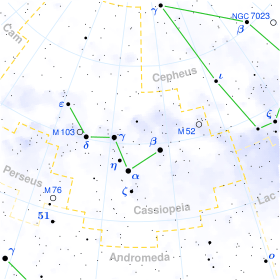S Cassiopeiae
 Location of S Cas | |
| Observation data Epoch J2000 Equinox J2000 | |
|---|---|
| Constellation | Cassiopeia |
| Right ascension | 01h 19m 41.99s[1] |
| Declination | 72° 36′ 40.8″[1] |
| Apparent magnitude (V) | +7.9 – +16.1[2] |
| Characteristics | |
| Spectral type | S3,4 – S5,8[3] |
| Variable type | Mira[2] |
| Astrometry | |
| Distance | 1,860 – 2,770 ly (570[4] - 850[5] pc) |
| Details | |
| Radius | 930[6] R☉ |
| Luminosity | 15,275[5] L☉ |
| Temperature | 1,800[6] K |
| Other designations | |
| Database references | |
| SIMBAD | data |
S Cassiopeiae (S Cas, HD 7769) is a Mira variable star in the constellation Cassiopeia.
Distance
In the absence of a measure of its parallax by the Hipparcos satellite, its distance from the solar system is estimated between 1,860 and 27,700 light-years.
Spectral type
Spectral type S3,4e-S5,8e, S Cassiopeiae is an S-type star, similar to Chi Cygni; these are asymptotic giant branch stars similar to those of class M, except that the dominant spectral bands of metal oxides are formed by metals of the fifth period of the periodic table as zirconium or yttrium. Another feature of this class of stars is the high mass loss; in the case of S Cassiopeiae it is estimated at 3.5 x 10-6 solar masses per year.[3]
Characteristics
It has a radius of 930 solar radii; if placed at the center of the Solar System, it would extend past the orbit of Mars. Its effective temperature is 1,800 K and its luminosity is 15,275 times the solar luminosity.
The second variable discovered in this constellation after R Cassiopeiae, S Cassiopeiae is, like this, a variable Mira. Its brightness between +7.9 and +16.1 magnitude over a period of 612.43 days. Look variables are stars in the last stages of its evolution whose instability comes from pulsations in its surface, causing changes in color and brightness. Some of them, among which is S Cassiopeiae show SiO maser emission.[7]
See also
Reference
- 1 2 Cutri, R. M.; Skrutskie, M. F.; Van Dyk, S.; Beichman, C. A.; Carpenter, J. M.; Chester, T.; Cambresy, L.; Evans, T.; Fowler, J.; Gizis, J.; Howard, E.; Huchra, J.; Jarrett, T.; Kopan, E. L.; Kirkpatrick, J. D.; Light, R. M.; Marsh, K. A.; McCallon, H.; Schneider, S.; Stiening, R.; Sykes, M.; Weinberg, M.; Wheaton, W. A.; Wheelock, S.; Zacarias, N. (2003). "VizieR Online Data Catalog: 2MASS All-Sky Catalog of Point Sources (Cutri+ 2003)". VizieR On-line Data Catalog: II/246. Originally published in: 2003yCat.2246....0C. 2246. Bibcode:2003yCat.2246....0C.
- 1 2 Samus, N. N.; Durlevich, O. V.; et al. (2009). "VizieR Online Data Catalog: General Catalogue of Variable Stars (Samus+ 2007-2013)". VizieR On-line Data Catalog: B/gcvs. Originally published in: 2009yCat....102025S. 1. Bibcode:2009yCat....102025S.
- 1 2 Ramstedt, S.; Schöier, F. L.; Olofsson, H.; Lundgren, A. A. (2006). "Mass-loss properties of S-stars on the AGB". Astronomy and Astrophysics. 454 (2): L103. Bibcode:2006A&A...454L.103R. doi:10.1051/0004-6361:20065285.
- ↑ Ramstedt, S.; Olofsson, H. (2014). "The 12CO/13CO ratio in AGB stars of different chemical type. Connection to the 12C/13C ratio and the evolution along the AGB". Astronomy & Astrophysics. 566: A145. Bibcode:2014A&A...566A.145R. doi:10.1051/0004-6361/201423721.
- 1 2 Guandalini, R.; Busso, M. (2008). "Infrared photometry and evolution of mass-losing AGB stars. II. Luminosity and colors of MS and S stars". Astronomy and Astrophysics. 488 (2): 675. arXiv:0806.4591
 . Bibcode:2008A&A...488..675G. doi:10.1051/0004-6361:200809932.
. Bibcode:2008A&A...488..675G. doi:10.1051/0004-6361:200809932. - 1 2 "Circumstellar molecular line emission from S-type AGB stars: mass-loss rates and SiO abundances". Astronomy and Astrophysics. 499 (2). 2009. Bibcode:2009A&A...499..515R. 515-527.
- ↑ Herpin, F.; Baudry, A.; Thum, C.; Morris, D.; Wiesemeyer, H. (2006). "Full polarization study of SiO masers at 86 GHz". Astronomy and Astrophysics. 450 (2): 667. Bibcode:2006A&A...450..667H. doi:10.1051/0004-6361:20054255.